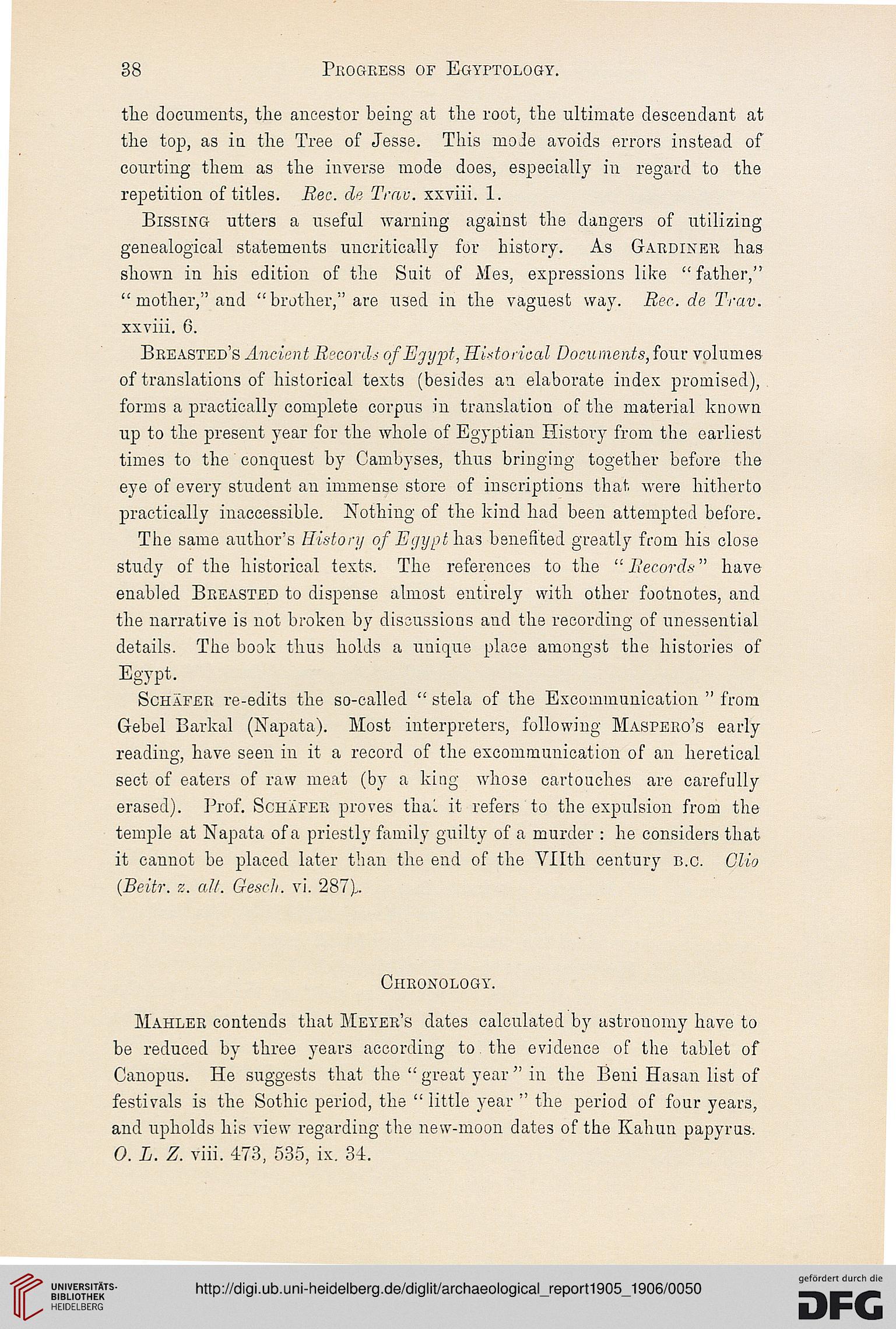38
Progress of Egyptology.
tlie documents, the ancestor being at the root, the ultimate descendant at
the top, as in the Tree of Jesse. This mode avoids errors instead of
courting them as the inverse mode does, especially in regard to the
repetition of titles. Rec. de Trav. xxviii. 1.
Bissing utters a useful warning against the dangers of utilizing
genealogical statements uncritically for history. As Gardiner has
shown in his edition of the Suit of Mes, expressions like "father,"
" mother," and "brother," are used in the vaguest way. Rec.de Trav.
xxviii. 6.
Breasted's Ancient Records of Egypt, Historical Documents, four volumes
of translations of historical texts (besides an elaborate index promised),
forms a practically complete corpus in translation of the material known
up to the present year for the whole of Egyptian History from the earliest
times to the conquest by Cambyses, thus bringing together before the
eye of every student an immense store of inscriptions that, were hitherto
practically inaccessible. Nothing of the kind had been attempted before.
The same author's History of Egypt has benefited greatly from his close
study of the historical texts. The references to the " Records" have
enabled Breasted to dispense almost entirely with other footnotes, and
the narrative is not broken by discussions and the recording of unessential
details. The book thus holds a unique place amongst the histories of
Egypt.
Schafer re-edits the so-called " stela of the Excommunication " from
Gebel Barkal (Napata). Most interpreters, following Maspero's early
reading, have seen in it a record of the excommunication of an heretical
sect of eaters of raw meat (by a king whose cartouches are carefully
erased). Prof. Schafer proves thaL it refers to the expulsion from the
temple at Napata of a priestly family guilty of a murder : he considers that
it cannot be placed later than the end of the Vllth century b.c. Clio
{Beitr. z. ait. Gesch. vi. 287)..
Chronology.
Mahler contends that Meyer's dates calculated by astronomy have to
be reduced by three years according to the evidence of the tablet of
Canopus. He suggests that the " great year " in the Beni Hasan list of
festivals is the Sothic period, the " little year " the period of four years,
and upholds his view regarding the new-moon dates of the Kahun papyrus.
0. L. Z. viii. 473, 535, ix. 34.
Progress of Egyptology.
tlie documents, the ancestor being at the root, the ultimate descendant at
the top, as in the Tree of Jesse. This mode avoids errors instead of
courting them as the inverse mode does, especially in regard to the
repetition of titles. Rec. de Trav. xxviii. 1.
Bissing utters a useful warning against the dangers of utilizing
genealogical statements uncritically for history. As Gardiner has
shown in his edition of the Suit of Mes, expressions like "father,"
" mother," and "brother," are used in the vaguest way. Rec.de Trav.
xxviii. 6.
Breasted's Ancient Records of Egypt, Historical Documents, four volumes
of translations of historical texts (besides an elaborate index promised),
forms a practically complete corpus in translation of the material known
up to the present year for the whole of Egyptian History from the earliest
times to the conquest by Cambyses, thus bringing together before the
eye of every student an immense store of inscriptions that, were hitherto
practically inaccessible. Nothing of the kind had been attempted before.
The same author's History of Egypt has benefited greatly from his close
study of the historical texts. The references to the " Records" have
enabled Breasted to dispense almost entirely with other footnotes, and
the narrative is not broken by discussions and the recording of unessential
details. The book thus holds a unique place amongst the histories of
Egypt.
Schafer re-edits the so-called " stela of the Excommunication " from
Gebel Barkal (Napata). Most interpreters, following Maspero's early
reading, have seen in it a record of the excommunication of an heretical
sect of eaters of raw meat (by a king whose cartouches are carefully
erased). Prof. Schafer proves thaL it refers to the expulsion from the
temple at Napata of a priestly family guilty of a murder : he considers that
it cannot be placed later than the end of the Vllth century b.c. Clio
{Beitr. z. ait. Gesch. vi. 287)..
Chronology.
Mahler contends that Meyer's dates calculated by astronomy have to
be reduced by three years according to the evidence of the tablet of
Canopus. He suggests that the " great year " in the Beni Hasan list of
festivals is the Sothic period, the " little year " the period of four years,
and upholds his view regarding the new-moon dates of the Kahun papyrus.
0. L. Z. viii. 473, 535, ix. 34.





